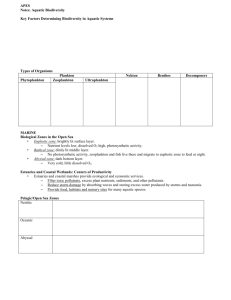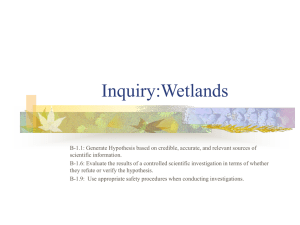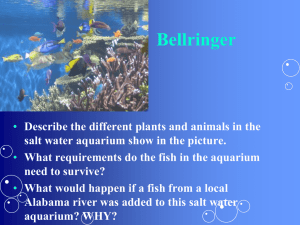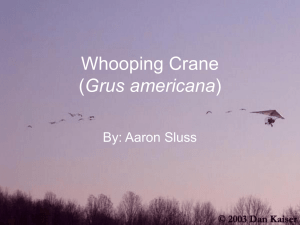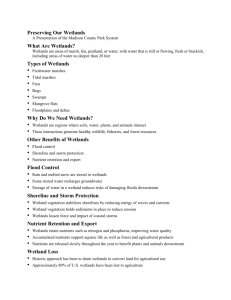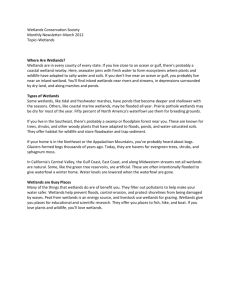Wetlands
advertisement
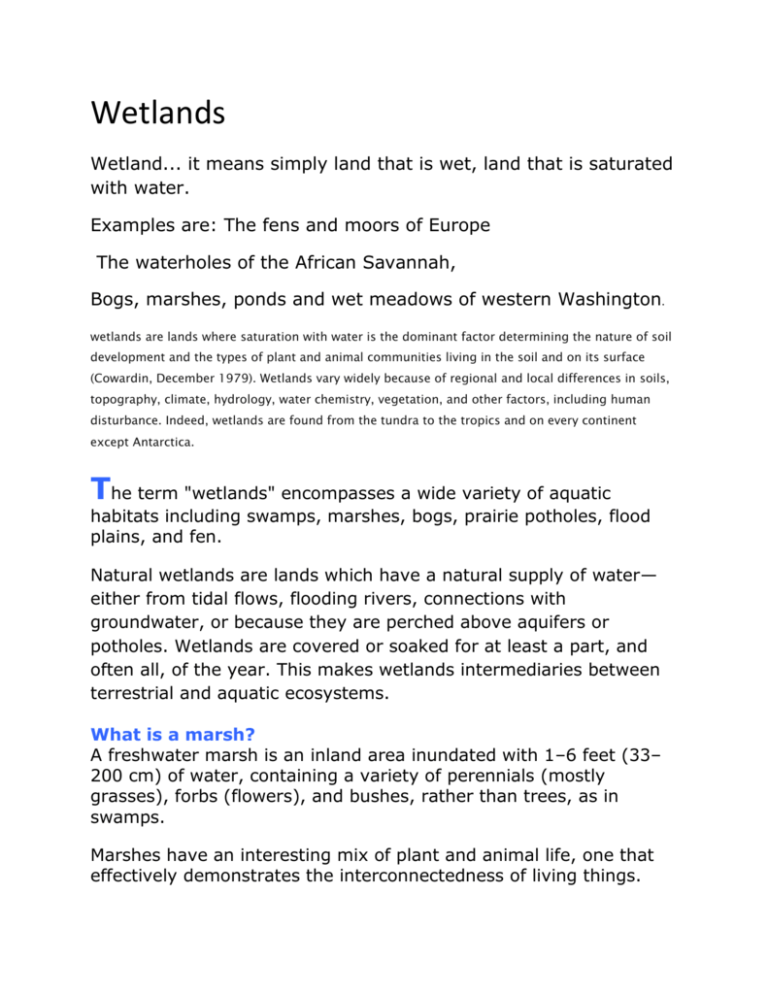
Wetlands Wetland... it means simply land that is wet, land that is saturated with water. Examples are: The fens and moors of Europe The waterholes of the African Savannah, Bogs, marshes, ponds and wet meadows of western Washington. wetlands are lands where saturation with water is the dominant factor determining the nature of soil development and the types of plant and animal communities living in the soil and on its surface (Cowardin, December 1979). Wetlands vary widely because of regional and local differences in soils, topography, climate, hydrology, water chemistry, vegetation, and other factors, including human disturbance. Indeed, wetlands are found from the tundra to the tropics and on every continent except Antarctica. The term "wetlands" encompasses a wide variety of aquatic habitats including swamps, marshes, bogs, prairie potholes, flood plains, and fen. Natural wetlands are lands which have a natural supply of water— either from tidal flows, flooding rivers, connections with groundwater, or because they are perched above aquifers or potholes. Wetlands are covered or soaked for at least a part, and often all, of the year. This makes wetlands intermediaries between terrestrial and aquatic ecosystems. What is a marsh? A freshwater marsh is an inland area inundated with 1–6 feet (33– 200 cm) of water, containing a variety of perennials (mostly grasses), forbs (flowers), and bushes, rather than trees, as in swamps. Marshes have an interesting mix of plant and animal life, one that effectively demonstrates the interconnectedness of living things. They are home to yellow-headed and red-winged blackbirds, herons, egrets, rails, bitterns, moorhens, ducks and geese. Most migratory species, in fact, rely on a network of wetlands to get from their southern habitats to nest sites further north. Muskrats are central to many marshes, keeping aggressive plants in check and crafting bird protection by carving out habitat. Minks and otters frequent wetlands. Raccoons, opossums, even moose can be found foraging around marshes, particularly when water levels drop. Marshes also host frogs, turtles, and snakes, salamanders, and an immense variety of insects, including aquatic, flying, and grazing insects. What is a swamp? Swamps are slow moving streams, rivers or isolated depressions that host trees and some shrubs. What is a bog? A bog is a peat-accumulating wetland. Some shrubs and evergreens grow in bogs, as do mosses. Most water comes from precipitation. There is usually no direct inflow or outflow of water. What is a prairie pothole? A prairie pothole is a wetland area found in the northern Great Plains. These shallow or bowl-like depressions have variable wetness. They are often used for breeding by birds. Prairie potholes are not yearlong. What is a riparian marsh? Marshes that occur along rivers are called riparian marshes. These marshes serve two ecological roles: to absorb excess water when river levels are high and to release water when river levels are low. These balancing forces help prevent floods and droughts. Some scientists believe that the great Mississippi River flood of 1993 was worsened, in part, by the loss of these wetlands. Why Are Wetlands Important? A Marsh in Scotland The Role of Wetlands in an Ecosystem Wetlands prevents flooding by holding water much like a sponge. By doing so, wetlands help keep river levels normal and filter and accept water during storms and whenever water levels are high. When water levels are low, wetlands slowly release water. They purify the surface water. Wetlands also release vegetative matter into rivers, which helps feed fish in the rivers. Wetlands help to counter balance the human effect on rivers by rejuvenating them and surrounding ecosystems. Many animals that live in other habitats use wetlands for migration or reproduction. For example, herons nest in large old trees, but need shallow areas in order to wade for fish and aquatic life. Amphibians often forage in upland areas but return to the water to mate and reproduce While wetlands are truly unique, they must not be thought of as isolated and independent habitat. To the contrary, wetlands are vital to the health of all other biomes and to wildlife and humans everywhere. Unlike most other habitats, wetlands directly improve other ecosystems. Because of its many cleansing benefits, wetlands have been compared to kidneys. The analogy is good one. Wetlands and kidneys both help control water flow and cleanse the system. Emergent ----plants firmly rooted in the muddy bottom but with stalks that rise high above the water surface. Emergent are able to radically slow the flow of water. As a result, they counter the erosive forces of moving water along lakes and rivers, and in rolling agricultural landscapes. Erosion control efforts in aquatic areas often include the planting of wetlands plants. Right now there is an attempt to rejuvenate Florida's Everglades. Crooked Tree Wildlife Sanctuary is in Belize, a small country in Central America, near Mexico and Guatemala Famous wetlands: 1. The Pantanal is the world’s largest wetland of any kind, lying mostly in Western Brazil but extending into Bolivia and Paraguay . 2. The Sundarbans is the largest littoral mangrove belt in the world spreading across Bangladesh and West Bengal in India. 3. The Okavango Delta in Botswana is one of the world’s great inland waterways. It is formed where the Okavango River empties onto a basin in the Kalahari Desert, where most of the water is lost to evaporation and transpiration instead of draining into the sea. 4. The Everglades are a vast, shallow, slow moving river of grass that extends from Lake Okeechobee to Florida Bay. 5. The Kerala backwaters are a chain of lagoons and lakes lying parallel to the Arabian Sea coast in the Kerala state in southern India. The network includes five large lakes linked by canals, both manmade and natural, fed by 38 rivers 6. Kakadu National Park is a diverse park about half the size of Switzerland located in the Northern Territory of Australia. 7. The Mekong Delta is the region in southern Vietnam 8. The iSimangaliso Wetland Park in South Africa 9. Wasur National Park is a massive wetland region in the Indonesian province of Papua, on the island of New Guinea 10. The Camargue on the Rhone River delta in the southeast of France. Wetland types Forested wetland: A forest floor of saturated, mucky soil. Trees found here might include Sitka spruce, Oregon ash, and cottonwoods. Shrub/scrub wetland: Water saturated soil covered by dense shrubbery such as dogwood, crabapple, salmonberry, and hardhack. Bog: A thick mat of sphagnum moss encircling or covering a small lake or pond containing cranberry, Labrador tea, and bog laurel. Some local bogs have been around almost 10,000 years! Wet meadow: Areas that often look like soggy pastures of grasses, rushes, and sedges. Marsh: The small lakes and ponds full of cattails, pond lilies, yellow iris, and many other types of plant life. Marshes that occur along the coastline are salt marshes. Marshes o Tidal o Nontidal Wet Meadows Prairie Potholes Vernal Pools Playa Lakes Tidal marsh along the Edisto River, South Carolina Marshes are defined as wetlands frequently or continually inundated with water, characterized by emergent soft-stemmed vegetation adapted to saturated soil conditions. There are many different kinds of marshes, ranging from the prairie potholes to the Everglades, coastal to inland, freshwater to saltwater. All types receive most of their water from surface water, and many marshes are also fed by groundwater. Nutrients are plentiful and the pH is usually neutral leading to an abundance of plant and animal life. For the purposes of this publication, we have divided marshes into two primary categories: tidal and non-tidal. Functions & Values Marshes recharge groundwater supplies and moderate stream flow by providing water to streams. This is an especially important function during periods of drought. The presence of marshes in a watershed helps to reduce damage caused by floods by slowing and storing flood water. As water moves slowly through a marsh, sediment and other pollutants settle to the substrate, or floor of the marsh. Marsh vegetation and microorganisms also use excess nutrients for growth that can otherwise pollute surface water such as nitrogen and phosphorus from fertilizer. This wetland type is very important to preserving the quality of surface waters. In fact, marshes are so good at cleaning polluted waters that people are now building replicas of this wetland type to treat wastewater from farms, parking lots, and small sewage plants. Description Non-tidal marshes are the most prevalent and widely distributed wetlands in North America. They are mostly freshwater marshes, although some are brackish or alkaline. They frequently occur along streams in poorly drained depressions, and in the shallow water along the boundaries of lakes, ponds, and rivers. Water levels in these wetlands generally vary from a few inches to two or three feet, and some marshes, like prairie potholes, may periodically dry out completely. It is easy to recognize a non-tidal marsh by its characteristic soils, vegetation, and wildlife. Highly organic, mineral rich soils of sand, silt, and clay underlie these wetlands, while lily pads, cattails (see photo), reeds, and bulrushes provide excellent habitat for waterfowl and other small mammals, such as Red-winged Blackbirds, Great Blue Herons, otters, and muskrats. prairie potholes, playa lakes, vernal pools, and wet meadows are all examples of non-tidal marshes. o Functions & Values Due to their high levels of nutrients, freshwater marshes are one of the most productive ecosystems on earth. They can sustain a vast array of plant communities that in turn support a wide variety of wildlife within this vital wetland ecosystem. As a result, marshes sustain a diversity of life that is way out of proportion with its size. In addition to their considerable habitat value, non-tidal marshes serve to mitigate flood damage and filter excess nutrients from surface runoff. Description Tidal marshes can be found along protected coastlines in middle and high latitudes worldwide. They are most prevalent in the United States on the eastern coast from Maine to Florida and continuing on to Louisiana and Texas along the Gulf of Mexico. Some are freshwater marshes, others are brackish (somewhat salty), and still others are saline (salty), but they are all influenced by the motion of ocean tides. Tidal marshes are normally categorized into two distinct zones, the lower or intertidal marsh and the upper or high marsh. In saline tidal marshes, the lower marsh is normally covered and exposed daily by the tide. It is predominantly covered by the tall form of Smooth Cord grass .The saline marsh is covered by water only sporadically, and is characterized by Short Smooth Cord grass, Spike Grass, and Salt meadow Rush .Saline marshes support a highly specialized set of life adapted for saline conditions. Brackish and fresh tidal marshes are also associated with specific plants and animals, but they tend to have a greater variety of plant life than saline marshes. Functions & Values Tidal marshes serve many important functions. They buffer stormy seas, slow shoreline erosion, and are able to absorb excess nutrients before they reach the oceans and estuaries. High concentrations of nutrients can cause oxygen levels low enough to harm wildlife, such as the "Dead Zone" in the Gulf of Mexico. Tidal marshes also provide vital food and habitat for clams, crabs, and juvenile fish, as well as offering shelter and nesting sites for several species of migratory waterfowl. A swamp is any wetland dominated by woody plants. There are many different kinds of swamps, ranging from the forested Red Maple, swamps of the Northeast, to the extensive bottomland hardwood forests found along the sluggish rivers of the Southeast. Swamps are characterized by saturated soils during the growing season, and standing water during certain times of the year. The highly organic soils of swamps form a thick, black, nutrientrich environment for the growth of water-tolerant trees such as some swamps are dominated by shrubs, such as Buttonbush or Smooth Alder. Plants, birds, fish, and invertebrates such as freshwater shrimp, crayfish, and clams require the habitats provided by swamps. Many rare species, such as the endangered American Crocodile depend on these ecosystems as well. Swamps may be divided into two major classes, depending on the type of vegetation present: shrub swamps, and forested swamps Forested swamps are found throughout the United States. They are often inundated with floodwater from nearby rivers and streams. Sometimes, they are covered by many feet of very slowly moving or standing water. In very dry years they may represent the only shallow water for miles and their presence is critical to the survival of wetland-dependent species like Wood Ducks. Shrub swamps, are similar to forested swamps, except that shrubby vegetation such as Buttonbush, Willow, Dogwood and Swamp Rose predominates. In fact, forested and shrub swamps are often found adjacent to one another. The soil is often water logged for much of the year, and covered at times by as much as a few feet of water because this type of swamp is found along slow moving streams and in floodplains. Mangrove swamps are a type of shrub swamp dominated by mangroves that covers vast expanses of southern Florida. This Eastern Mud Salamander (Pseudotriton montanus) is resting on sphagnum moss. Sphagnum creates bogs by holding water and creating acidic conditions. Sphagnum itself may be up to 70 percent water. Description Bogs are one of North America's most distinctive kinds of wetlands. They are characterized by spongy peat deposits, acidic waters, and a floor covered by a thick carpet of sphagnum moss. Bogs receive all or most of their water from precipitation rather than from runoff, groundwater or streams. As a result, bogs are low in the nutrients needed for plant growth, a condition that is enhanced by acid forming peat mosses. There are two primary ways that a bog can develop: bogs can form as sphagnum moss grows over a lake or pond and slowly fills it , or bogs can form as sphagnum moss blankets dry land and prevents water from leaving the surface . Over time, many feet of acidic peat deposits build up in bogs of either origin. The unique and demanding physical and chemical characteristics of bogs result in the presence of plant and animal communities that demonstrate many special adaptations to low nutrient levels, waterlogged conditions, and acidic waters, such as carnivorous plants. Carlisle Bog in Alaska. Unlike the rest of the United States, Alaska still has most of its wetlands. Functions and Values Bogs serve an important ecological function in preventing downstream flooding by absorbing precipitation. Bogs support some of the most interesting plants in the United States (like the carnivorous Sundew), and provide habitat to animals threatened by human encroachment. Status Bogs in the United States are mostly found in the glaciated northeast and Great Lakes regions (northern bogs), but also in the southeast (pocosins). Their acreage declined historically, as they were drained to be used as cropland, and mined for their peat which was used as a fuel and a soil conditioner. Recently, bogs have been recognized for their role in regulating the global climate by storing large amounts of carbon in peat deposits. Bogs are unique communities that can be destroyed in a matter of days, but require hundreds, if not thousands, of years to form naturally. This bog in Nova Scotia, Canada is dominated by ericaceous dwarf-shrubs, a common family of plants in the peat bogs of the Northeast. Description Northern bogs are generally associated with low temperatures and short growing seasons where ample precipitation and high humidity cause excessive moisture to accumulate. Therefore, most bogs in the United States are found in the northern states. Northern bogs often form in old glacial lakes. They may have either considerable amounts of open water surrounded by floating vegetation or vegetation may have completely filled the lake. The sphagnum peat of northern bogs cause especially acidic waters. The result is a wetland ecosystem with a very specialized and unique flora and fauna that can grow in these conditions called acidophiles. Nevertheless, bogs support a number of species of plants in addition to the characteristic Sphagnum Moss, including Cotton Grass, Cranberry, Blueberry, Pine, Labrador Tea, and Tamarack. Moose, deer, and lynx are a few of the animals that can be found in northern bogs. The Greater Sandhill Crane, the Sora Rail, and the Great Gray Owl depend on bogs for survival. The Northern Pitcher Plant (Sarracenia purpurea) overcomes the nutrient deficiencies of bog life by capturing insects in pools of water in its leaves and digesting them with the help of some local bacteria. The Northern Pitcher Plant's flower looks much like the Sweet Pitcher Plant's (see below). Pocosins are densly vegetated with trees and shrubs. They are subjected to fire about every 10 to 30 years. Description The word pocosin comes from the Algonquin Native American word for "swamp on a hill". These evergreen shrub and tree dominated landscapes are found on the Atlantic Coastal Plain from Virginia to northern Florida, though most are found in North Carolina. Usually, there is no standing water present in pocosins, but a shallow water table leaves the soil saturated for much of the year.They range in size from less than an acre to several thousand acres located between and isolated from old or existing stream systems in most instances. Because pocosins are found in broad, flat, upland areas far from large streams, they are ombrotrophic like northern bogs, meaning rain provides most of their water. Also like the bogs of the far north, pocosins are found on waterlogged, nutrient poor, acid soils. The soil itself is a mixture of peat and sand containing large amounts of charcoal from periodic burnings. These natural fires occur because pocosins periodically become very dry in the spring or summer. The fires are ecologically important because they increase the diversity of shrub types in pocosins. Pocosins provide large tracks of undisturbed land needed by Black Bears (Ursus americanus). The most common plants are evergreen trees (Loblolly Bay, Red Bay, and Sweet Bay), and evergreen shrubs (titi, fetterbush, and zenobia). Pocosins provide important habitat for many animals, including some endangered species like the red-cockaded woodpecker. They are especially important as the last refuge for Black Bears in coastal Virginia and North Carolina, and the Red Wolf has recently been reintroduced in North Carolina pocosins. Sweet bay Zenobia Functions and values Habitat is the most valuable function of Pocosins. Some pocosins are very large and difficult to develop, and so they remain largely undisturbed. As a result, they are a haven for species adapted to living in unaltered forests. As more and more land is developed in the Eastern United States, pocosins are becoming ever more valuable refuges for wildlife. The slow movement of water through the dense organic matter in pocosins removes excess nutrients deposited by rainwater. The same organic matter also acidifies the water. This very pure water is slowly released to estuaries, where it helps to maintain the proper salinity, nutrients, and acidity. This process is important to help maintain healthy fish populations important to both commerce and recreation. Pocosins are also sources of valuable timber and fuel, but these uses can harm or destroy pocosins if they are not carried out responsibly. The Sweet Pitcher Plant is one of the carnivorous plants found in porcinis. Status About 1,400 square miles of undisturbed porcinis remain today. By comparison, more than 3,000 square miles were drained between 1962 and 1979. Historically, porcinis were mostly threatened by agriculture. Today, timber harvesting, peat mining, and phosphate mining join agriculture as the biggest threats to the remaining undisturbed porcinis. Swamps o Forested Swamps o Bottomland Hardwoods Shrub Swamps Mangrove Swamps Bogs o o Fens Northern bogs Pocosins If You Were the Scientist Can you think like a scientist? Put yourself into a scientist's shoes by taking this quiz. You've been called-up to recommend a new test for assessing the health of Great Lakes coastal wetlands. The assay will be to test the chemical composition of fish larvae as a way to measure the relative health of a coastal wetland – you will be measuring the carbon and nitrogen stable isotope ratios in the fish tissue. The carbon stable isotope ratio, C-13, will track the energy flow through the ecosystem – in impacted systems energy primarily flows through phytoplankton because other sources of primary production are light-limited in degraded, turbid environments. The nitrogen stable isotope ratio, N-15, will track the amount of excess nutrients because septic systems and sewage processing plants give-off nitrogen with a different isotopic ratio than is naturally found in the environment. TEST 1 what type of signal do you propose will be associated with degraded wetlands? HINTS: 1. Atmospheric carbon is relatively enriched in C-13 compared to respired carbon from aquatic sediments. 2. Ground water with atmospheric nitrate has lower N-15 amounts than ground water with nitrate derived from human and animal wastes. a. Less C-13 and less N-15 b. Less C-13 and more N-15 c. More C-13 and less N-15 d. More C-13 and more N-15
